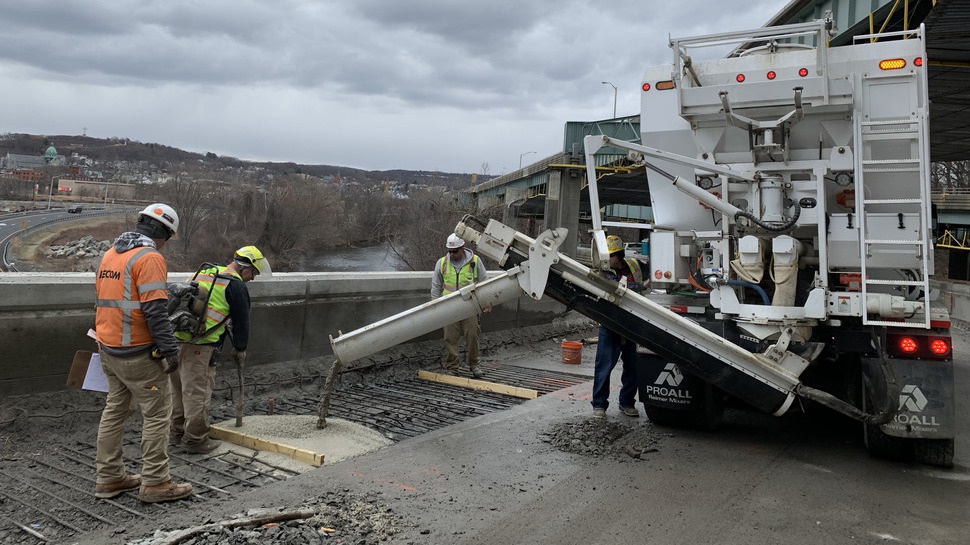
The high-speed interchange at State Route 8 and Interstate 84 in Connecticut was a relatively new engineering design when it opened to traffic in the late 1960s. Not only were stacked bridges unusual at that time, but the elevated interchange’s left- and right-hand entrance and exit ramps over city streets and a river made it unique in the state. Residents nicknamed it the Mixmaster.
The design saved valuable space in the fast-growing city of Waterbury. Although it’s in the middle of the state, the city is part of the “New York to Hartford corridor,” a mix of densely populated urban and suburban communities along I-84 and rural townships in the north.
When the Mixmaster opened, average daily traffic was 100,000. Today it’s almost twice that number – 190,000 – and is expected to reach 225,000 by 2045. Reducing traffic congestion on I-84 by eliminating bottlenecks and restoring bridges and other infrastructure – such as the Mixmaster – is necessary to continue economic growth.
The Connecticut DOT (CTDOT) and engineering firm HNTB Corp. are planning and designing the Mixmaster’s replacement. The “New Mix” could cost $7 billion and would begin construction in the 2040s. To maintain driving public safety until then, the interchange is in the midst of a $153-million rehabilitation designed to extend service life 25 years.
Strong, Fast, and Durable Patching
In addition to steel, substrate, joint, and drainage repairs as well as parapet modifications and new signage, Walsh Construction is making partial- and full-depth repairs to the reinforced concrete decks of 10 bridges.
To minimize inconvenience to the driving public by minimizing closures times, CTDOT requires repair material to reach 2500 psi compressive strength in 1 hour and 3500 psi at 24 hours. To meet this requirement, the contractor is patching the bridge decks with Rapid Set® DOT Cement concrete.
A blend of ASTM C1600 calcium sulfoaluminate (CSA) Rapid Set® Cement and plasticizer, DOT Cement reaches 3140 psi (21.6 MPa) at 1.5 hours and 4650 psi (32.1 MPa) at 24 hours. It’s air-entrained for long life in freeze-thaw regions like New England.
Locally sourced coarse rock and sand are added to the cement powder at the jobsite in a portable mechanical mixer or, for greater efficiency, a volumetric mixer truck that has separate compartments for each mix component and produces up to 80 yards at a time.
One yard of Rapid Set® DOT Cement concrete requires 658 pounds of DOT Cement; 1,800 pounds of 3/8-inch coarse rock; and 1,200 pounds of sand. The volumetric mixer’s computerized batching controls are carefully calibrated to ensure the correct amounts of sand, rock, and cement are automatically conveyed to the truck’s auger, where they’re mixed with the correct amount of water. The concrete then flows down a chute at the back of the truck.
“For small projects, contractors can use Rapid Set® DOT Concrete Mix, which already contains aggregate,” says CTS representative Mark Connelly. “However, contractors on large jobs usually use a volumetric mixer and buy DOT Cement in 2,000-lb. (907.2-kg) ‘supersacks’ instead of 50-lb. (22.7-kg) bags. The DOT supplies the aggregate. An eight-person crew can mix and place about 60 yards a night – 10 times the amount they would with a concrete drum mixer.”
DOT Cement concrete is finished just like portland cement concrete – screed, hand trowel and/or bull float – but cures much faster. Placements should be water-cured for at least 1 hour. Alternative curing methods, such as an ASTM C309 curing compound, may be suitable in some applications.
Rapid Set® Extends Construction Season
Unlike concrete made with portland cement, Rapid Set® cement concrete reaches structural strength so quickly that placements can be returned to service much more quickly in winter weather. Rapid Set® mixes can gain structural strength in 1 hour. That means contractors spend much less time and effort protecting placements from cold temperatures and wind.
Walsh Construction follows ACI 306 “Guide to Cold Weather Concreting” principles and uses glycol ground heaters to keep recently placed concrete at about 50 degrees. Although the guide is written for concrete mixes made with ASTM C150 portland cement, the same principles apply to concrete mixes made with Rapid Set® Cement, which is an ASTM C1600 rapid-hardening cement.
CTS’ Mark Connelly explains this at a safety day that Walsh Construction organizes for vendors and CTDOT employees every winter.
“Connecticut has used Rapid Set® DOT Cement for more than two decades, but there are always engineers who are amazed by the material – how quickly it sets and gains strength. I tell contractors to stage the job as they usually do, but devise a Plan B for anything and everything that could go wrong before flipping the switch on that mixer. Every second counts with a rapid-hardening cement, so you don’t want to waste time searching for tools or crew members.”
